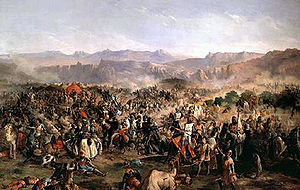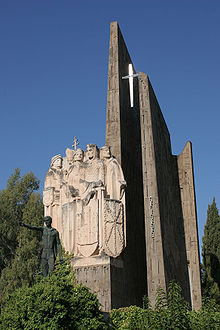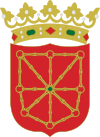- Battle of Las Navas de Tolosa
-
Battle of Las Navas de Tolosa Part of the Reconquista 
A fanciful portrayal of the battleDate July 16, 1212 Location Near Las Navas de Tolosa, Jaén, Andalusia, 38°17′04″N 3°34′58″W / 38.28443°N 3.58286°W Result Decisive Christian victory[1] Belligerents  Castile
Castile
 Aragon
Aragon
 Portugal
Portugal
 Navarre
Navarre Almohads
AlmohadsCommanders and leaders Alfonso VIII of Castile-center
Sancho VII of Navarre-right wing
Pedro II of Aragon-left wing[2]Muhammad al-Nasir Strength ~50,000 ~200,000[3] Casualties and losses ~2,000 dead or wounded[citation needed] 100,000 - 150,000 dead, wounded, or captured[4][5] Covadonga – Clavijo – Albelda – Monte Laturce – Valdejunquera – Simancas – Estercuel – Torrevicente – Cervera – Calatañazor – Torà – Albesa – Graus – Barbastro – Cabra – Piedra Pisada – Morella – Sagrajas – Alcoraz – Uclés – Cutanda – Ourique – Oreja – Montiel – 1st Santarém – Lisbon – 2nd Santarém – Alarcos – Las Navas de Tolosa – Jerez – Teba – Río Salado – GranadaThe Battle of Las Navas de Tolosa, known in Arab history as the Battle of Al-Uqab (معركة العقاب), took place on 16 July 1212 and was an important turning point in the Reconquista and in the medieval history of Spain.[6] The forces of King Alfonso VIII of Castile were joined by the armies of his Christian rivals, Sancho VII of Navarre, Pedro II of Aragon and Afonso II of Portugal in battle[7] against the Berber Muslim Almohad rulers of the southern half of the Iberian Peninsula. The sultan Caliph al-Nasir (Miramamolín in the Spanish chronicles) led the Almohad army, made up of people from the whole Almohad empire. Most of the men in the Almohad army came from the African side of the empire, which included Morocco, Algeria, Tunisia and even as far away as Mauritania and Senegal and much of the Iberian peninsula's southern half.
Contents
Background
In 1195, Alfonso VIII of Castile had been defeated by the Almohads in the so-called Disaster of Alarcos. After this victory the Almohads had taken important cities as Trujillo, Plasencia, Talavera, Cuenca and Uclés. Then, in 1211, Muhammad al-Nasir had crossed the Strait of Gibraltar with a powerful army, and invaded the Christian territory and captured the stronghold of the Calatrava Knights in Salvatierra. After this, the threat was so great for the Iberian Christian kingdoms that Pope Innocent III called European knights to a crusade.
Previous movements
There were some disagreements among the members of the Christian coalition: French and other European knights were not used to the Iberian summer heat, but more importantly, they did not agree with Alfonso's merciful treatment of Jews and Muslims that were previously defeated in the conquest of Malagón and Calatrava la Vieja. Previously, they had caused problems in Toledo, (where the different armies of the Crusade gathered), with assaults and murders in the Jewish Quarter. More than 30,000 men deserted and returned to their homes across the Pyrenees.
Battle
Alfonso crossed the mountain range that defended the Almohad camp, sneaking through the Despeñaperros Pass, being led by a local shepherd that knew the area. The Christian coalition caught the Moorish army by surprise.
According to legend, the Caliph had his tent surrounded with a bodyguard of slave-warriors who were chained together as a defense. The Navarrese force led by their king Sancho VII broke through this bodyguard. The Caliph escaped, but the Moors were routed, leaving some 100,000 casualties on the battlefield. The victorious Christians seized several prizes of war: the tapestry covering the entrance to Al Nasir's tent was sent to the Abbey of Santa María la Real de Las Huelgas near Burgos where it remains on display to date, and Miramamolin's tent and standard were delivered to Pope Innocent III.
Christian losses were far fewer, only about 2,000 men (though not as few as legend had it). The losses were particularly heavy among the Orders. Those killed included Pedro Gomez de Acevedo (bannerman of the Order of Calatrava), Alfonso Fernandez de Valladares (comendator of the Order of Santiago), Pedro Arias (master of the Order of Santiago, died of wounds on 3 August) and Gomes Ramires (Portuguese master of the Knights Templar). Ruy Diaz (master of the Order of Calatrava) was so grievously wounded that he had to resign his command.
The Caliph Muhammad al-Nasir himself died shortly after the battle in Marrakech, where he had fled after the defeat.
After the battle, the kingdom of Navarre adopted a new coat of arms in memorial of Sancho's achievement. The new coat of arms featured a network of golden chains on a red field with an emerald. Today, it can be seen within the coat of arms of Spain.
Aftermath
The crushing defeat of the Almohads significantly hastened their decline both in the Iberian Peninsula and in the Maghreb a decade later. This would give further momentum to the Christian Reconquest begun by the kingdoms of northern Iberia centuries before, resulting in a sharp reduction in the already declining power of the Moors in the Iberian Peninsula. Shortly after the battle, the Castilians took Baeza and then Úbeda, major fortified cities near the battlefield, and gateways to invade Andalusia. Thereafter, Ferdinand III of Castile took Cordova in 1236, Jaén in 1246, and Seville in 1248; then he took Arcos, Medina-Sidonia, Jerez and Cadiz. After this chain of victories, only Ferdinand's death prevented the Castilians from crossing the Gibraltar Strait to take the war to the heartland of the Almohad empire.[citation needed] Ferdinand III died in Seville on May 30, 1252, when a plague spread over the southern part of the Iberian peninsula while he was preparing his army and fleet to cross the Straits of Gibraltar. On the Mediterranean coast, James I of Aragon, proceeded to conquer the Balearic Islands (from 1228 over the following four years) and Valencia (the city capitulated September 28, 1238).
By the year 1252, the Almohad empire was almost over, at the mercy of another emerging African power. In 1269, a new association of African tribes, the Marinid, had taken control of the Maghreb, and most of the former Almohad empire was under their rule. Later, the Marinids tried to recover the former Almohad territories in the Iberian peninsula, but they were definitively defeated by Sancho IV, Ferdinand's grandson, and King Afonso IV of Portugal in the Battle of Salado, the last major military encounter between large Christian and Muslim armies in the Iberian peninsula.
Moorish Granada
In 1294 Sancho IV retook the Taifa of Granada, key to the control of the Straits of Gibraltar. Granada, Almería and Málaga were the only major Muslim cities of the time remaining in the Iberian peninsula. These three cities were the core of the Nasrid dynasty and its Emirate of Granada, which was a vassal state of Castile, until the kingdom was finally taken by the Catholic Monarchs in 1492.
Notes
- ^ Gitlitz, David Martin and Linda Kay Davidson, The Pilgrimage Road to Santiago, (St.Martin's Press, 2000), 60.
- ^ Setton, Kenneth Meyer, A History of the Crusades, (University of Wisconsin Press, 1975), 423.
- ^ Nafziger, George F. and Mark W. Walton, Islam at War: a history, (Greenwood Publishing Company, 2003), 86.
- ^ According to the king of Castile, "On their side 100,000 armed men fell in battle..." See Lynn Hunt, R. Po-chia Hsia, Thomas R. Martin, Barbara H. Rosenwein, and Bonnie Smith, The Making of the West: Peoples and Cultures: A Concise History: Volume I: To 1740, Second Edition (New York: Bedford/St. Martin's 2007), 391.
- ^ Nafziger, 87.
- ^ Lynn Hunt describes the battle as a "major turning point in the reconquista..." See Lynn Hunt, R. Po-chia Hsia, Thomas R. Martin, Barbara H. Rosenwein, and Bonnie Smith, The Making of the West: Peoples and Cultures: A Concise History: Volume I: To 1740, Second Edition (New York: Bedford/St. Martin's 2007), 391.
- ^ Guggenberger, Anthony, A General History of the Christian Era: The Papacy and the Empire, Vol.1, (B. Herder, 1913), 372.
References
- Nafziger, George F. and Mark W. Walton, Islam at War: a history, Greenwood Publishing Company, 2003.
- Setton, Kenneth Meyer, A History of the Crusades, University of Wisconsin Press, 1975.
Further reading
- "Battle of Las Navas de Tolosa". Reader's Companion to Military History. http://college.hmco.com/history/readerscomp/mil/html/mh_028500_lasnavasdeto.htm. Retrieved 9 February 2006.
Categories:- Battles of the Reconquista
- 1212 in Europe
- Al-Andalus
- Battles involving the Almohad Caliphate
- Battles involving Castile
- Battles involving Aragon
- Battles involving Portugal
- Battles involving Morocco
- Battles of the Crusades
- Military history of Spain
- 13th century in Spain
- 13th-century crusades
- Conflicts in 1212
- Nasrid dynasty
Wikimedia Foundation. 2010.


